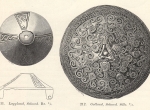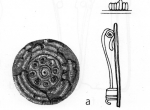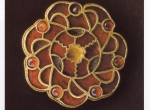Disc brooch
Disc brooch (Scheibenfibel), personal ornament typical for the late →Migration Period and the Merovingian period in Scandinavia, western and central Europe, on the Danube (fig. 1-2.); also, on Balt territory (→Olsztyn Group - fig. 3., →Elbląg Group , Sambia). A round, ornamented disc, the fastening as a rule in cross-bow design, fixed to the underside of the brooch; some specimens in a hinged design. A group of ornaments greatly varied in their morphology; in some brooches the disc is provided with half-round projections on its rim. Usually there is also a central knob, sometimes, inlaid with silver repoussé foil, decorated with almandines, filigree or by studding. Other frequent techniques - stamping and embossing. The designs are arranged into complex compositions covering the entire surface of the brooch.
AB-W
Literature: K. Høilund Nielsen, Zur Chronologie der jüngeren germanischen Eisenzeit auf Bornholm. Untersuchungen zu Schmuckgarnituren, “Acta Archaeologica” 1987, p. 63-63, 72-73; U. Koch, Das alamanisch-fränkische Gräberfeld bei Pleidelsheim, Stuttgart 2001, p. 164-166; K. Vielitz, Granatscheibenfibeln der Merowingerzeit, Montagnac 2003; G. Graenert, Merowingerzeitliche Filigranscheibenfibeln westlich des Rheins, Europe médiévale 7, Montagnac 2007.
-
 full resolution
full resolution
Fig. 1. Disc brooches from Sweden (Lappland, Gotland) (B. Salin, Die Altgermanische Thierornamentik, Stockholm 1904, Fig. 211, 212).
-
 full resolution
full resolution
Fig. 2. Tumiany (former Daumen), grave 97 (F. Jakobson, Die Brandgräberfelder von Daumen und Kellaren im Kreise Allenstein, Ostpr., Daumen und Kellaren – Tumiany i Kielary 2. Schriften des Archäologischen Landesmuseums 9. Neumünster 2009, Plate 59).
-
 full resolution
full resolution
Fig. 3. Gold disc brooch decorated in cloisonné technique. Schwerin-Mueß (Die Langobarden. Das Ende der Völkerwanderung, Katalog zur Ausstellung im Rheinischen LandesMuseum Bonn 22.8.2008 – 11.1.2009, p. 231).


